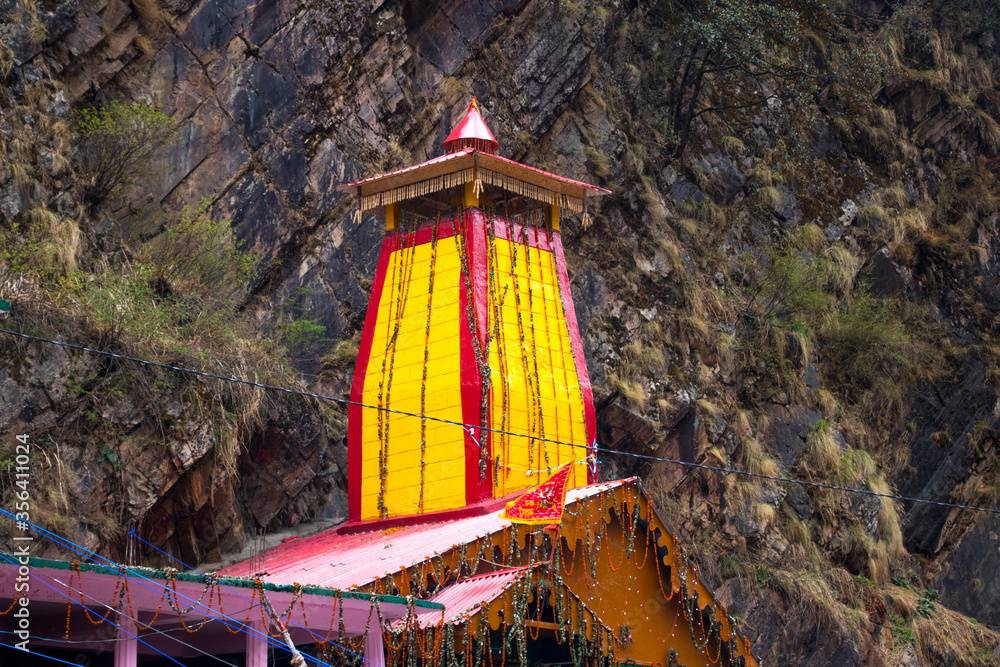The Char Dham Yatra is one of the most revered pilgrimages in Hinduism, attracting thousands of devotees annually. It involves a journey to four sacred shrines located in the Indian state of Uttarakhand. These shrines are Yamunotri, Gangotri, Kedarnath, and Badrinath, each holding immense religious significance. This pilgrimage not only holds deep spiritual significance but also offers a journey through the picturesque and serene landscapes of the Himalayas. Each site embodies a unique aspect of Hindu mythology and spirituality, making the Char Dham Yatra a profound and transformative experience for devotees.
Detailed Route Plan for the Char Dham Yatra:
The Char Dham Yatra involves a specific route that starts from either Haridwar or Rishikesh, both of which are major pilgrimage and tourist hubs in Uttarakhand. Here is a detailed breakdown of the traditional route for the Char Dham Yatra:
Yamunotri

- Route: Haridwar/Rishikesh → Barkot → Janki Chatti → Yamunotri
- Distance: Approximately 220 km from Haridwar to Janki Chatti
- Trek: 6 km trek from Janki Chatti to Yamunotri
The journey begins from Haridwar or Rishikesh and proceeds to Barkot, a small town in Uttarkashi district. From Barkot, travelers move to Janki Chatti, the last motorable point. The final leg to Yamunotri involves a 6 km trek, where devotees visit the Yamunotri temple dedicated to the goddess Yamuna.
Gangotri

- Route: Yamunotri → Barkot → Uttarkashi → Gangotri
- Distance: Approximately 230 km from Yamunotri to Gangotri
From Yamunotri, the route retraces back to Barkot and then moves towards Uttarkashi, another major town in the region. From Uttarkashi, pilgrims travel to Gangotri, the site of the temple dedicated to goddess Ganga, marking the origin of the holy Ganges River.
Kedarnath

- Route: Gangotri → Uttarkashi → Guptkashi → Gaurikund → Kedarnath
- Distance: Approximately 270 km from Gangotri to Gaurikund
- Trek: 16 km trek from Gaurikund to Kedarnath
After Gangotri, the journey continues back to Uttarkashi and then to Guptkashi. From Guptkashi, pilgrims reach Gaurikund, the last motorable point before Kedarnath. The final 16 km trek from Gaurikund to Kedarnath takes devotees to the sacred temple dedicated to Lord Shiva.
Badrinath
- Route: Kedarnath → Gaurikund → Guptkashi → Joshimath → Badrinath
- Distance: Approximately 220 km from Gaurikund to Badrinath
After visiting Kedarnath, pilgrims return to Gaurikund and then proceed through Guptkashi to Joshimath. From Joshimath, the journey continues to Badrinath, the temple dedicated to Lord Vishnu. Badrinath is situated between the Nar and Narayana mountain ranges and is considered the final destination of the Char Dham Yatra.
Return Journey
- Route: Badrinath → Joshimath → Rudraprayag → Rishikesh/Haridwar
- Distance: Approximately 300 km from Badrinath to Rishikesh
The return journey from Badrinath takes pilgrims back through Joshimath and Rudraprayag, eventually reaching Rishikesh or Haridwar. This route completes the Char Dham Yatra, bringing pilgrims back to where they started.
Approvals and Permits for the Char Dham Yatra
Embarking on the Char Dham Yatra requires pilgrims to obtain certain approvals and permits to ensure a smooth and safe pilgrimage. Here are the key requirements:
Yatra Registration
- Mandatory Requirement: All pilgrims must register for the Char Dham Yatra.
- Registration Methods:
- Online Registration: Pilgrims can register online through the official Uttarakhand Char Dham Devasthanam Management Board website. This provides a convenient option for pilgrims to complete the necessary formalities before starting their journey.
- In-Person Registration: Registration can also be done at designated centers in Haridwar, Rishikesh, and other locations. These centers are equipped to assist pilgrims with the registration process, ensuring everyone is accounted for during the yatra.
Biometric Registration:
- Mandatory for All Pilgrims: Biometric registration is a compulsory step for all pilgrims undertaking the Char Dham Yatra.
- Registration Centers: Biometric registration can be completed at various designated centers. These centers are typically located in key starting points of the yatra such as Haridwar, Rishikesh, and other major locations along the route.
The biometric registration process is implemented to enhance the security and safety of the pilgrims. It ensures that every pilgrim is recorded and can be accounted for during their journey. This step is crucial for managing the large number of pilgrims and for providing assistance in case of emergencies.
By completing both the yatra and biometric registrations, pilgrims help the authorities manage the yatra more effectively, ensuring a safer and more organized pilgrimage experience.
Read Other Blog:-Best Season to Visit Northeast India
Travel
- Weather Conditions:
- The Yatra season is typically from late April to October.
- Check weather forecasts and avoid the monsoon period (July to August) due to landslides and heavy rains.
- Accommodation:
- Book accommodations in advance, especially during peak season.
- Options range from budget guesthouses to Dharamshalas and hotels.
- Food:
- Carry light snacks and water.
- While there are many eateries along the route, food options may be basic.
- Local Transport:
- Utilize local buses, taxis, or hire private vehicles for the journey.
- Helicopter services are available for Kedarnath from Phata, Guptkashi, and other locations.
- Guides and Porters:
- Consider hiring local guides and porters for assistance, particularly for the trekking segments.
Safety
- Altitude Sickness:
- Be aware of symptoms of altitude sickness, such as headaches, nausea, and dizziness.
- Acclimatize properly, stay hydrated, and ascend gradually.
- Emergency Contacts:
- Keep emergency contact numbers handy, including local police, medical facilities, and the Uttarakhand Tourism helpline.

